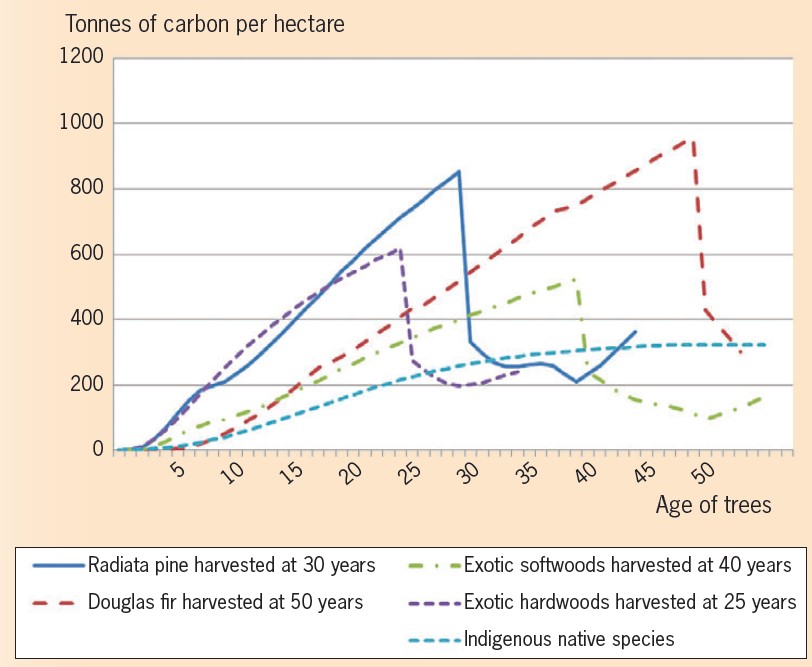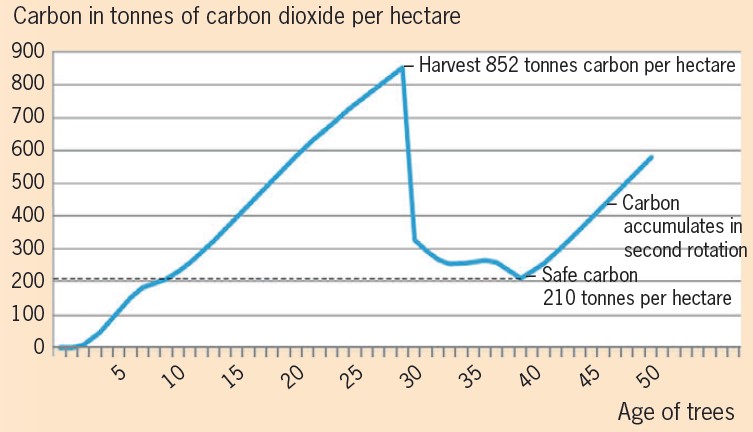Emissions Trading Scheme - Could it be changing for the better?
Stuart Orme, New Zealand Tree Grower May 2017.
The Emissions Trading Scheme managed under the Climate Change Response Act has been operational in New Zealand since the start of 2008. In that time we have seen policy interpretation shift from ‘saving the world’ to ‘saving money’ and back to ‘saving the world’ under different political managers and changing international landscapes. With the adoption of the Paris Accord, there is a realisation that −
- Most nations are actively looking to support emission reduction
- New Zealand will be in a major carbon deficit if it does not increase afforestation by an increase in newly forested land in the very near future.
There is an expectation that New Zealand’s Emissions Trading Scheme policy could be set to provide some certainty over the next 10 years for land owners considering planting additional land in trees.
Many species including manuka, kanuka and radiata pine are considered eligible species and are accordingly modelled in this article. As mentioned in the February Tree Grower, different species of trees have different growth rates, likely rotation lengths and timber. The graph below illustrates how carbon accumulates in different species over their typical rotations. I would just remind those who have forgotten, one tonne of carbon is equivalent to one ‘credit’ or one New Zealand Unit.
Currently, at harvest, most carbon is classed as being lost back to the atmosphere. The carbon stored in stumps, roots and branches is termed residual carbon, so the carbon balance lines on the graph do not fall back to zero. The indigenous species are not harvested, but will continue indefinitely to store carbon at a steady rate.
The graph has been produced using standard data provided by the Ministry for Primary Industries in their Emissions Trading Scheme look-up tables. The tables were provided in the early days of the scheme to enable owners of small forests to claim their carbon credits without needing to undertake relatively expensive forest measurement. The graph illustrates the advantage of radiata pine as a fast-growing and relatively early-maturing species compared with the alternatives. It has become clear that the MPI standardised data is very general. We have learned from our own forest inventory that it is essential to use real data to gauge accurately the total carbon stored in any given forest. This data has also been invaluable to show the carbon variation between individual forests.

Carbon liabilities and when they are incurred
Under the Emissions Trading Scheme, forestry participants are allocated carbon units or NZUs, and are required to surrender the units based on all changes in carbon stocks. Current rules state that at harvest, carbon which has been allocated to the trees in question must be repaid to MPI with the exception of residual carbon. This, as mentioned earlier, is defined as the carbon left in the branches and roots of the trees on site after harvest.
This figure, although retained initially, is in fact a delayed surrender as it is calculated as a gradual decrease over the first 10 years after harvest. Although this progressive loss is accounted for in annual carbon balances, as the second rotation trees start to grow, the carbon total balance becomes positive again before the total residual carbon is assumed to be returned to the atmosphere. This point where the emissions calculation becomes positive has been called safe, although we prefer the name ‘enduring’ carbon.
Enduring carbon
As with many aspects of the Emissions Trading Scheme, calculating enduring carbon is complex. The actual amount depends on a number of factors including the planting date of the forest and when the forest was registered into the scheme. In the case of forests planted in 2008 or after, the amount of enduring carbon equates roughly to the first 10 years’ worth of carbon stored in the trees. In forests planted before 2008, the percentage of enduring carbon gradually diminishes with increased age. Any forests planted before 2003 have very little, if any, enduring carbon.
Technically, this type of carbon can be sold at any time without obligation. However, if the land or forest was sold, a new buyer might be reluctant to take on the carbon accounting record against the registered land, even though as long as the land stays in forest use, the surrender might not ever be triggered.

The above table indicates hypothetical carbon accumulation in the first and second rotations of radiata pine. In this scenario, trees are harvested at age 30 when they contain 852 tonnes of carbon per hectare. The carbon balance drops to 332 tonnes a hectare and the owner is liable for 852 minus 332 tonnes, or 520 tonnes per hectare at harvest.
The balance continues to decline for the next ten years to 210 tonnes a hectare and the owner incurs further liability of 332 minus 210 or 122 tonnes a hectare. The carbon curve then starts to recover. Over the time period of around 40 years, the participant has returned 520 plus 122, or 642 tonnes per hectare of carbon to MPI. The participant retains 210 tonnes per hectare of enduring carbon, which can be sold with limited obligation.
The ETS Review and possible future changes
The Emissions Trading Scheme is seen as a mechanism to increase new forest planting and contribute to New Zealand’s emissions reduction targets. It is currently under review by the government. At present, registered participants from forests planted since 1989 are required to surrender the majority of the carbon claimed via an emissions return after harvest, excluding any enduring or safe carbon. The second rotation’s carbon then increases before harvest takes place again. This is known as a saw tooth model.
The large liability seen at harvest also applies if forest cover is lost due to wind storm, fire or any other catastrophic event. The risk involved with having to repay a large number of NZUs at an unknown price is a significant factor affecting forest owners or potential forest owners and their willingness to plant new forests, join the Emissions Trading Scheme, and therefore contribute to emissions reduction targets.
The government has made it known they are very keen to increase the number of new trees planted to help offset emissions. At the same time, forest owners want a simpler more predictable payment regime, with lower risk, lower measurement and lower compliance costs.
Two options have been proposed which change the way forestry carbon is accounted for. Both aim to reduce the risk to forest owners by deferring some of the liability currently incurred at harvest across multiple rotations. These two options are known as harvested wood products and averaging. They have been mentioned before in articles about the Emissions Trading Scheme and are also outlined in the article on page 26 about climate change.
Harvested wood products
After harvest, trees are converted into wood products, ranging from paper, to timber used in buildings and furniture, all of which have different life spans. These products store carbon which will eventually be released at the end of their useful life. The current Emissions Trading Scheme makes no allowance for carbon stored in harvested wood products, but assumes the wood instant oxidises at harvest.
Accounting methods which include recognition for harvested wood products mean that some liability would be deferred over the lifetime of these products. This accounting is complex, especially as so much of New Zealand’s timber is exported as logs. Under some projections, based on the half-life of the main domestic end-uses only − sawn timber, panels, pulp, paper, and fuel wood − it is suggested the owner’s liability at harvest could be reduced by between 50 and 60 or per cent.
These figures would most probably only apply to harvest of trees still currently in the ground. There would be no liabilities at harvest as long as the land was replanted. Beyond this, it is suggested that some sort of nationally calculated deferred liability for harvested wood products could be combined with averaging.
This would incorporate the emissions calculation and therefore the enduring carbon of harvested wood products into the long-term average figure of carbon stored in forests, and therefore the carbon claimed by a participant with each emissions return.
Averaging
Averaging would allow forest owners to receive the NZUs averaged over a number of years during the forest’s first rotation. The participant would have the option of accepting an allocation of NZUs based on approximately the first 20 years of carbon sequestered in a rotation. This allocation would carry no obligation and would not be required to be surrendered at harvest, as long as the forest is re-planted. It could also mean that, if the forest was destroyed in a catastrophic event such as by fire or disease, the owner would not be liable for the carbon lost, as long as the forest was re-planted and the land use continues to meet the forest land definition
Averaging is not a new concept and is currently applied under Australia’s Carbon Farming Initiative. The terms of any proposed averaging system have yet to be finalised or made known to the New Zealand forest industry.
Ideal carbon accounting method
As the current Emissions Trading Scheme consultation comes to a close it is hoped that the government will consider adopting the above system and allow a forest grower to choose which method of carbon calculation best suits their situation.
- A grower with indigenous forest or growing trees specifically for carbon production would stick with the current situation which allows the long term accumulation of all carbon
- A large forest company may prefer to adopt the harvested wood products method
- A woodlot owner may prefer averaging.
Should harvested wood products and averaging be adopted along with the current methods, the ability to manage carbon obligations will become significantly easier than present with the potential carbon credit and cash flows improved. It will be a game changer for current forest owners and a significant catalyst for new forest plantings. Watch this space. Better still, lobby hard for the adoption of added carbon accounting approaches while they are under consideration.
Stuart Orme is a Registered Forestry Consultant based in Masterton.

 Farm Forestry New Zealand
Farm Forestry New Zealand